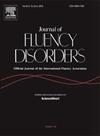Stuttering severity and social anxiety among adults who stutter: A multilevel analysis
IF 2.1
3区 医学
Q1 AUDIOLOGY & SPEECH-LANGUAGE PATHOLOGY
引用次数: 0
Abstract
Purpose
The purpose of this study is to further investigate the association between social anxiety and stuttering severity among adults who stutter (AWS) at both the between- and within-person levels of analysis.
Method
Sixty-two AWS (women = 27, men = 35; Mage = 39.5 years, SDage = 14.8) first completed a questionnaire (e.g., trait social anxiety and personality traits) and provided two speech samples (i.e., conversation, reading). Then, participants enrolled in up to 21 days of ecological momentary assessment (EMA) to self-report their momentary stuttering severity, social anxiety, and avoidance behaviors during social interactions. Correlational analyses and hierarchical regression analyses were conducted on between-person level measures. Multilevel mediation analysis was conducted on EMA data to disaggregate between- and within-person processes.
Results
At the between-person level, percent syllables stuttered (%SS) and person mean Self-Reported Stuttering Severity (iSRSS) were both significantly correlated with trait social anxiety, but not above and beyond the effects of neuroticism, extraversion, the overall impact of stuttering, and avoidance behaviors. At the within-person level, when AWS self-reported to stutter more than they usually do on average, they also tended to exhibit higher levels of social anxiety than they usually did, regardless of the amount of avoidance behaviors exhibited at those moments. The within-person effect between stuttering severity and social anxiety was also significantly mediated by avoidance behaviors.
Conclusion
The associations between social anxiety and stuttering differed based on the analysis level (between vs within-person) and whether covariates are included.
成人口吃者的口吃严重程度与社交焦虑:多层次分析
方法62名口吃成人(女性27人,男性35人;平均年龄39.5岁,平均年龄14.8岁)首先填写了一份调查问卷(如特质社交焦虑和人格特质),并提供了两份语音样本(即对话和朗读)。然后,参与者参加长达 21 天的生态瞬间评估(EMA),以自我报告他们在社会交往中的瞬间口吃严重程度、社交焦虑和回避行为。对人与人之间的测量结果进行了相关分析和分层回归分析。结果在人与人之间,口吃音节百分比(%SS)和个人平均自述口吃严重程度(iSRSS)均与特质社交焦虑显著相关,但不超越神经质、外向性、口吃的总体影响和回避行为的影响。在个人层面上,当 AWS 自我报告的口吃程度平均高于他们通常的口吃程度时,他们也倾向于表现出比通常更高的社交焦虑水平,而不管在这些时刻表现出多少回避行为。结论:社交焦虑与口吃之间的关联因分析水平(人与人之间或人与人之间)和是否包含协变量而有所不同。
本文章由计算机程序翻译,如有差异,请以英文原文为准。
求助全文
约1分钟内获得全文
求助全文
来源期刊

Journal of Fluency Disorders
AUDIOLOGY & SPEECH-LANGUAGE PATHOLOGY-REHABILITATION
CiteScore
3.70
自引率
14.30%
发文量
23
审稿时长
>12 weeks
期刊介绍:
Journal of Fluency Disorders provides comprehensive coverage of clinical, experimental, and theoretical aspects of stuttering, including the latest remediation techniques. As the official journal of the International Fluency Association, the journal features full-length research and clinical reports; methodological, theoretical and philosophical articles; reviews; short communications and much more – all readily accessible and tailored to the needs of the professional.
 求助内容:
求助内容: 应助结果提醒方式:
应助结果提醒方式:


